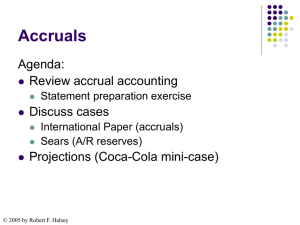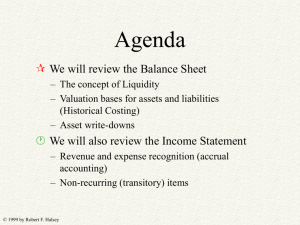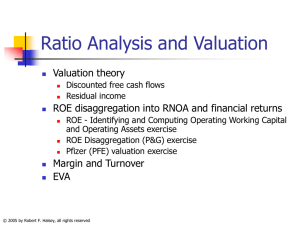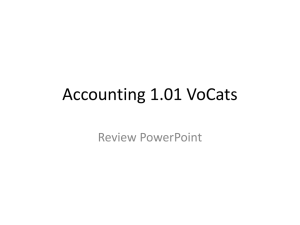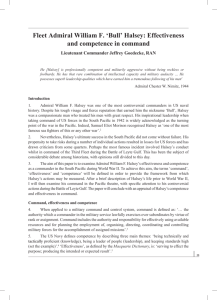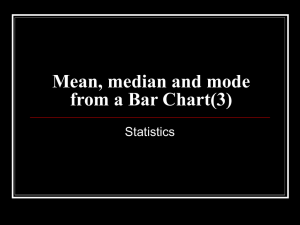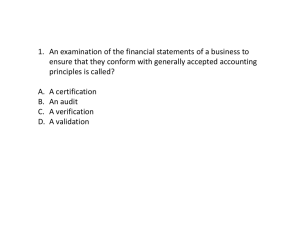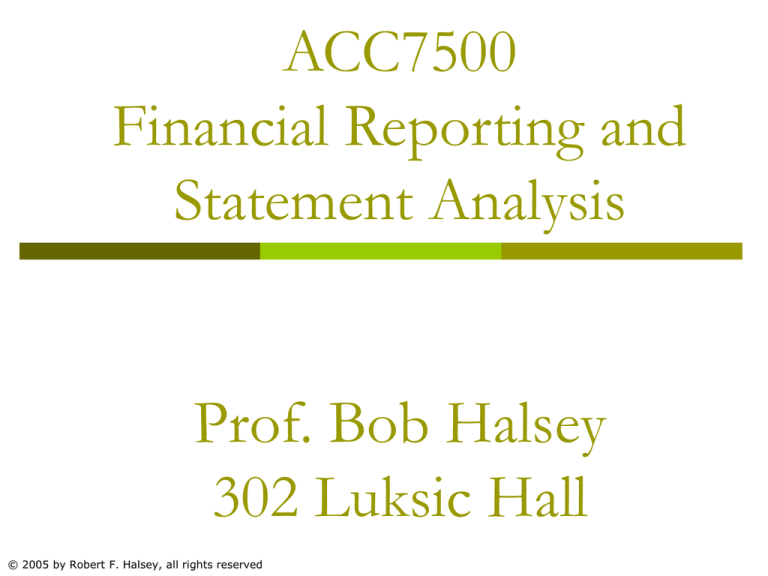
ACC7500
Financial Reporting and
Statement Analysis
Prof. Bob Halsey
302 Luksic Hall
© 2005 by Robert F. Halsey, all rights reserved
Introduction
Course focus on footnotes
Syllabus/Schedule/Resources
Most of the action is here
Review ACC7000/FIBD notes if you haven’t already
Text: Wild, Subramanyam and Halsey (WSH), FSA, 8th ed.
Blackboard (http://blackboard.babson.edu/ )
Bring mini-cases to class
Outside help: Wednesday afternoons or by appt., email,
phone.
I’m a nice guy and I’m here to help
Questions are ok … really!
Please, let’s share our ideas, but keep focused and not
too many tangents
© 2005 by Robert F. Halsey, all rights reserved
Course content
Financial statements
Overview
Cash Flow
Accruals
Core earnings
Projections
Foreign Currency
Translation
Deferred Taxes
Earnings Management
Valuation
DCF
Residual Income
ROE Disaggregation
review
© 2005 by Robert F. Halsey, all rights reserved
Off Balance Sheet
Investments
Leasing
VIEs
Derivatives
Pensions
Passive
Equity method
Consolidations
Equity transactions
Equity carve outs
Convertibles
Stock Options
Transaction Analysis
Grace’s Dress Company
© 2005 by Robert F. Halsey, all rights reserved
Initial capital contribution of $1,000 into the business; borrow $500 to be repaid
$100 per period @ 2% per period. Purchase 10 dresses $500 on account and
fixtures, furniture and equipment for $500 in cash (depreciate over 5 periods):
amount
Sales
Cost of goods Sold
Gross profit
Wage expense
Depreciation expense
Interest expense
Net profit
ASSETS
Cash
Accounts Receivable
Inventories
Amount
LIABILITIES
Accounts payable
Wages payable
Note Payable
Furn, Fix & Equip
Accumulated Depreciation
Furn, Fix & Equip (net)
EQUITY
Total Assets
Total Liabilities and Equity
© 2005 by Robert F. Halsey, all rights reserved
Contributed Capital
Earned Capital
amount
Sell 5 dresses for $600 on account that cost $250; employees earn wages of
$100 to be paid next month; record depreciation expense, pay interest on note,
repay principal, and pay off account payable:
amount
Sales
Cost of goods Sold
Gross profit
Wage expense
Depreciation expense
Interest expense
Net profit
ASSETS
Amount
Cash
Accounts Receivable
Inventories
LIABILITIES
Accounts payable
Wages payable
Note Payable
Furn, Fix & Equip
Accumulated Depreciation
Furn, Fix & Equip (net)
EQUITY
Total Assets
Total Liabilities and Equity
© 2005 by Robert F. Halsey, all rights reserved
Contributed Capital
Earned Capital
amount
Review of Financial Statements
DuPont Mini-case
© 2005 by Robert F. Halsey, all rights reserved
Transitory Items
Sales
- Cost of Goods Sold (COGS)
Gross Margin (GM)
- General, Sales and Admin. Costs (SGA)
- Interest
- Taxes
Earnings From Continuing Operations
± Discontinued Operations (net of tax)
± Extraordinary Items (net of tax)
± Changes in accounting Principles (net of tax)
Net Earnings
- Dividends
Change in Retained Earnings
© 2005 by Robert F. Halsey, all rights reserved
Transitory Items
Items below the line (e.g., Cont. Ops.)
Discontinued operations
Extraordinary items (will reduce in the
future)
Changes in accounting principles
Transitory items above the line
Gains (losses) on asset sales / debt
repurchase (no longer an extraordinary
item)
Restructuring expenses (write-downs and
accruals)
© 2005 by Robert F. Halsey, all rights reserved
Frequency of Extraordinary Items
Proportion of Companies
Reporting
Pos count %
Neg count %
Total
14%
12%
10%
8%
6%
4%
2%
0%
85 86 87 88 89 90 91 92 93 94 95 96 97 98 99 00 01 02 03 04
Magnitude of Extraordinary Items
Median absolute
magnitude as a
percent of sales
Median pos %
Median neg %
Total
3.0%
2.0%
1.0%
0.0%
85 86 87 88 89 90 91 92 93 94 95 96 97 98 99 00 01 02 03 04
Year
© 2005 by Robert F. Halsey, all rights reserved
Frequency of Special Items
Proportion of
companies reporting
Pos count %
Neg count %
Total
50%
40%
30%
20%
10%
0%
85 86 87 88 89 90 91 92 93 94 95 96 97 98 99 00 01 02 03 04
Year
Magnitude of Special Items
Median absolute
value as a percent
of sales
Median pos %
Median neg %
Total
4%
3%
2%
1%
0%
85 86 87 88 89 90 91 92 93 94 95 96 97 98 99 00 01 02 03 04
Year
© 2005 by Robert F. Halsey, all rights reserved
Discontinued Operations
Separately identifiable business segment being disposed
Disclosure – segregate operating results from continuing
operations:
Income (loss) from operations from BOY to
measurement date (net of tax)
Gain (loss) on disposal (net of tax)
Operating income from measurement date to
disposal date
Gain (loss) from disposal
Recognize losses, defer gains
Adjust income statement retroactively for comparative
years
May also segregate assets & cash flows
© 2005 by Robert F. Halsey, all rights reserved
Effect of Disc Ops on Inc. Stmt.
© 2005 by Robert F. Halsey, all rights reserved
Frequency of Discontinued Operations
Proportion of
companies reporting
Pos count %
Neg count %
Total
14%
12%
10%
8%
6%
4%
2%
0%
85 86 87 88 89 90 91 92 93 94 95 96 97 98 99 00 01 02 03 04
Year
Magnitude of Discontinued Operations
Median absolute
magnitude as a
percent of sales
Median pos %
Median neg %
Total
5%
4%
3%
2%
1%
0%
85 86 87 88 89 90 91 92 93 94 95 96 97 98 99 00 01 02 03 04
Year
© 2005 by Robert F. Halsey, all rights reserved
HP mini-case
1.
2.
3.
4.
5.
6.
Briefly describe the accounting for assets and income of discontinued
operations. That is, how are sales, expenses, profits and net assets
reported in the financial statements?
What were the sales and net profits for the discontinued operations in
1999?
Prepare a summary balance sheet of the discontinued operations as of
7/31/99.
How are the assets, liabilities and equity of the discontinued operations
reflected in HP’s balance sheet?
How do discontinued operations affect analysis of the financial
condition of the company? That is, within the framework of the DuPont
analysis, how does the accounting for discontinued operations affect
net profit margin, turnover and financial leverage?
What adjustments might you wish to make to HP’s reported financial
results in your analysis of the company?
© 2005 by Robert F. Halsey, all rights reserved
© 2005 by Robert F. Halsey, all rights reserved
© 2005 by Robert F. Halsey, all rights reserved
© 2005 by Robert F. Halsey, all rights reserved
HP Mini-case #5
NPM (NI/Sales)
TAT (Sales/TA)
LEV (TA/TE)
Reported
3491/42370
8.20%
42370/35297
1.2
35297/18295
1.9
ROE
© 2005 by Robert F. Halsey, all rights reserved
19%
(3491-387)/42370
42370/(35297-3533)
(35297-3533)/(18295-3533)
w/o DO
7.30%
1.3
2.2
21%
Intangible Assets
Asset Measurement mini-case
© 2005 by Robert F. Halsey, all rights reserved
ACC7500 asset measurement mini-case
The use of historical costing is justified on the basis of objectivity
and verifiability, which arguably lessen potential bias in financial
statements by reducing the degree of subjectivity in the amounts
reported. This focus on objectivity often means that information which
would otherwise be relevant to financial statement users might be
omitted since it is usually more subjective in nature. The book value of
stockholder’s equity is reported in conformity with GAAP and often is
different from the market value of the company, which is equal to the
market price of the firm’s shares multiplied by the numbers of common
shares outstanding.
Remembering that the characteristic of an asset is the expectation
that it will produce future benefits (net cash inflows), identify three
“assets” which might be omitted from the balance sheet and, thereby,
contribute to the difference between the market value and the book
value of the company (i.e., think of “assets” which investors might view
as important for the determination of firm value, but which are excluded
from the balance sheet because their measurement is too subjective):
© 2005 by Robert F. Halsey, all rights reserved
Sarbanes-Oxley
Management more accountable - Sarbanes-Oxley
assertions:
I have reviewed the report
F/S not materially misleading
F/S fairly represent the financial condition of Co.
Internal controls are sufficient
© 2005 by Robert F. Halsey, all rights reserved
EY Resigns Over
Selectrica Internal Control Deficiencies
1.
2.
3.
4.
5.
6.
Accounts receivable and services revenue incorrectly included a
general reserve position in the allowance for doubtful accounts as of
December 31, 2004, and incorrectly recorded a receivable as
uncollectible as of March 31, 2005, for which payment was
subsequently received after March 31 but prior to the completion of the
quarterly close process.
Cash equivalents as well as short-term and long-term investments
were not classified in the accordance with generally accepted
accounting principles during the treasury process for Selectica's India
subsidiary.
Selectica failed to reverse deferred revenue when all criteria for
revenue recognition had occurred.
The company failed to record the expenses related to the benefits
extended when employees were fired.
Deficiencies in its financial statement close process included
insufficient controls over the monitoring of the terms of employment
agreements and bonus programs and determining the related
appropriate accounting treatment.
The company also cited insufficient controls over the monitoring of
accrued liabilities recorded upon the sale of the company's E-insurance
business to Accenture in December 2003. The company said it had
incorrectly not reversed the accrual when the related obligation
expired on December 31, 2004. An adjustment as of that date to
decrease accrued liabilities and decrease G&A expense was recorded
prior to the issuance of the December 31, 2004, financial statements.
© 2005 by Robert F. Halsey, all rights reserved
Who sets accounting standards?
SEC created by 1933,1935 acts of Congress to
regulate securities industry and to establish
reporting requirements
SEC has delegated standard setting to private
industry: FASB
But, Public Company Accounting Oversight Board
(PCAOB) controls FASB’s funds. SEC oversees
PCAOB
Bottom line: accounting standard setting is very
much a political process. Compromises limit the
effectiveness of accounting standards.
© 2005 by Robert F. Halsey, all rights reserved

